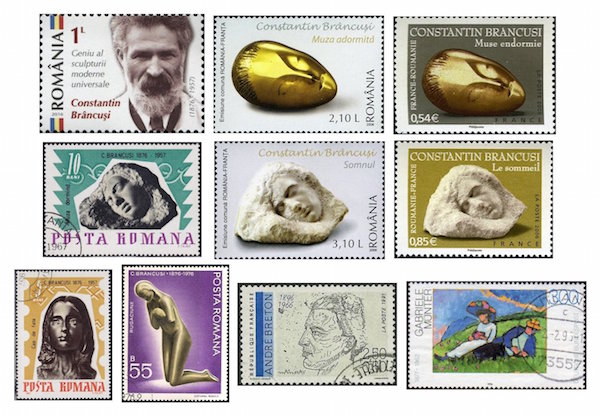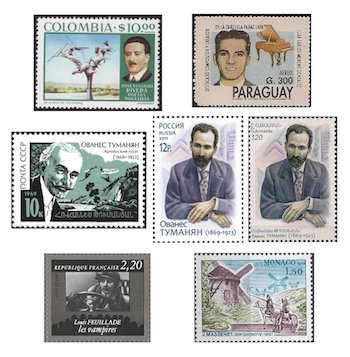The Arts on the Stamps of the World — February 19
An Arts Fuse regular feature: the arts on stamps of the world.

By Doug Briscoe
Although there is no stamp for her, I would be remiss not to mention that today is the 100th anniversary of the birth of the great Carson McCullers (February 19, 1917 – September 29, 1967).
And although he was not an artist (in the strict sense), it seems to me I should also pay tribute to one of the seminal figures in science, Nicolaus Copernicus (1473 – 24 May 1543), so I show just a few of the many, many stamps issued for him worldwide.
Now on to our birthday artists: Constantin Brâncuşi and André Breton top the list, and we have stamps honoring German expressionist painter Gabriele Münter, Colombian poet José Eustasio Rivera, Paraguayan composer Juan Carlos Moreno González, Armenian poet Hovhannes Tumanyan, and French silent film director Louis Feuillade.

The great Romanian sculptor Constantin Brâncuşi (February 19, 1876 – March 16, 1957) was born in poverty in the Carpathians and worked from the age of seven, at first as a sheepherder, but he exhibited a gift for carving, producing farm tools at an early age. Later he worked as a domestic and at the age of eighteen crafted a violin out of spare materials (he was to become an able performer on the instrument). Luckily his talent was noted, and he was given the chance to attend a local school of arts and crafts. From there, it was on to the Bucharest School of Fine Arts and academic training in sculpture, and from there to Munich and Paris, where he was invited to work in Rodin’s studio. His highly individual style began to manifest itself soon thereafter, and his work was well received, appearing the the 1913 Armory Show in New York City. Perhaps his finest work was the World War I monument he created in 1938 in Târgu-Jiu, near his chilhood home. After that, he did relatively little work, only some dozen or fifteen pieces. At his home in Paris he was cared for by a Romanian refugee couple, and he adopted French citizenship in 1952 so that he could make them his heirs. His studio and works, however, he donated to the Paris National Museum of Modern Art, and the artist is buried in Montparnasse Cemetery. Naturally most Brâncuşi stamps come from Romania, but I include two pairs issued conjointly by Romania and France in 2006. This practice of two countries issuing the same design (with minor variations) on the same day is not at all uncommon, as we shall see below.
French writer André Breton (1896 – 28 September 1966) gave us Surrealism, writing the first Surrealist Manifesto in 1924, in which year he was also one of the key founders of the Bureau of Surrealist Research, a “think tank,” as we might call it today, for investigations into creative expressions of the unconscious mind. A related development was Breton’s notion of “automatic writing,” in which the poet yields conscious control over the creative process. He joined the French Communist Party in 1927, was expelled in 1933, and in 1938 went to Mexico on a cultural commission from the French government for the opportunity to meet Trotsky with Diego Rivera and Frida Kahlo. With his background in medicine and psychiatry, Breton served in both World Wars in the medical corps. Vichy banned his work, and Breton was able to escape to the United States and the Caribbean in 1941. His fascination with the workings of the mind drew him to the study of Voodoo possession in Haiti. He returned to France in 1946. An inveterate collector, his home contained more than 5,000 items, and Claude Lévi-Strauss said that he never knew Breton to have made a mistake regarding the authenticity or quality of an exotic object.
The remarkable German expressionist painter Gabriele Münter (1877 – 19 May 1962) had the good fortune, particularly in the era of her youth, to be supported by her parents in her pursuit of an artistic career; they provided her with a private tutor and later with an education at the Woman’s Artist School (women not being permitted to attend classes at the German Academies in those blinkered days). Münter lost both her indulgent parents by age 21, but was left financially independent. After a two-year sojourn to the American Midwest, she returned to Germany for studies at the Phalanx School in Munich, where her work was taken seriously for the first time by the institution’s director, Wassily Kandinsky. Soon their relationship developed into something more personal despite Kandinsky’s marriage. Together they helped found the New Artists’ Association (Neue Künstlervereinigung) and, with Franz Marc, the expressionist group Der Blaue Reiter (The Blue Rider). Her affair with Kandinsky ended after about twelve years, and Münter, who had been a fiercely committed artist in many media, went into a fallow period, but she resumed working in the late 1920s. With the coming of fascism and its condemnation of modernist movements, Münter rescued many works of art by hiding them in her home for safekeeping. In 1957 she donated all of this material to a Munich gallery. Though best known for her landscapes, the German stamp of 1994 gives us her Couple Lying on Grass (aka Jawlensky and Werefkin) from 1909.

The best known work of Colombian writer José Eustasio Rivera Salas (1888 – December 1, 1928) is his epic novel La vorágine (The Vortex, 1924). To some, this is one of the most important novels to come out of Latin America. Like Jorge Amado’s later work The Violent Land, a grim picture of cacao plantations in the Bahia region of Brazil, Rivera’s novel deals with the plight of rubber workers in the Amazon basin. Rivera also addressed these issues as a lawyer and journalist. Another significant book is Tierra de promisión (1921), a collection of 55 sonnets. Rivera came to the United States in 1928 in hopes of having his novel translated into English and made into a film, but he suffered seizures, probably from malaria, and went into a four-day coma from which he never recovered. The hamlet where he was born was incorporated into a new municipality that was later renamed Rivera in his honor.
February 19 is also the birthday of another South American artist, Paraguayan composer Juan Carlos Moreno González (1911 – 30 January 1983). When he was eleven years old, he lost both legs in a dreadful accident while playing on railroad cars. Thus ended his and his parents’ hopes that he might become a concert pianist. He pressed on with his musical studies, however, and received a government grant to study composition in Italy from 1938 to 1940. He is perhaps best known for his popular songs, particularly the tango “Margarita,” recorded by Carlos Gardel, and as the co-creator, with writer Manuel Frutos Pane, of Zarzuela Paraguayan, a genre of operetta that uses Paraguayan folklore as its subject matter. He also wrote music classical in form, modeled on Beethoven, but often infused with native harmonies. Examples include a symphonic poem called “Kuarahy mimby” (Whistling Heron), a Piano Concerto in One Movement, and two piano sonatas. Moreno González was also admired for his teaching and served as director of the Asunción Municipal Conservatory of Music from its founding in 1964.
Hovhannes Tumanyan ([O.S. February 7] 1869 – March 23, 1923) is considered to be the national poet of Armenia, beloved also for his tireless and courageous activism. Besides the stamp, his image can be seen on the Armenian 5,000 dram banknote. Tumanyan’s lineage can be traced to an ancient Armenian princely family. He spent his youth in Tiflis (now Tbilisi), where he worked in journalism and formed a literary group at his home in 1899. He was twice arrested for attempting to intercede in the government-provoked Armenian–Tatar massacres of 1905–07. In 1921, he went to Constantinople to seek help for Armenian refugees. (In the same year he founded the House of Armenian Art in Tiflis.) But his efforts took a toll on his health; he underwent surgery in 1922, but died in a Moscow hospital the following year. Tumanyan’s works have inspired a considerable number of films and at least two operas, Anush (1912) by Armen Tigranian and Almast (1930) by Alexander Spendiaryan. As was the case with José Eustasio Rivera, Tumanyan’s native village was renamed for him, but only from 1938 to 1969. The Soviet Union released a stamp for him in the latter year, and another joint issue, like the one for Brâncuşi we saw above, came out in 2011.

Louis Feuillade (1873 – 25 February 1925) directed as many as 800 silent films (certainly over 600), many of them shorts and serials, from 1906 to 1924. Of course, in his youth he could never have anticipated such a career and was drawn rather to literature, drama, and vaudeville. He published some poems and earned a reputation as an aficionado of bullfighting with his articles on that subject. As early as 1905 he submitted screenplays to Gaumont Film Company, which were not only accepted but handed over to Feuillade to direct himself! By 1907 he had been made Gaumont’s Artistic Director. Today he is remembered mostly for his serials Fantômas (five episodes, 1913), Les Vampires (ten episodes, 1915) and Judex (twelve episodes, 1916). The last named series seems to have been the inspiration for the American crimefighting character The Shadow, and Feuillade’s approach to the making of thrillers was a likely influence on such later masters as Fritz Lang and Alfred Hitchcock. The Fantômas films were restored in 2006. The stamp is drawn from a French sheet I recently acquired that pays tribute to several directors of French film. We saw the Truffaut stamp from the set earlier this month.
Just yesterday we noted the 115th anniversary of the first performance of Massenet’s Le jongleur de Notre-Dame. Today is the 107th anniversary of the première of the same composer’s comic opera Don Quichotte, first presented at the Opéra de Monte-Carlo on 19 February 1910. Both stamps, along with four others, come from a set issued by Monaco in 1979.
Recently we showed a stamp for Thomas Edison on his birthday. I included him mainly for his work in sound capture and reproduction. On this day in 1878 Edison patented the phonograph.
Other artists born on this day who in my view deserve a stamp but don’t yet have one (besides Carson McCullers) are English actor David Garrick (1717 – 20 January 1779), Italian composer Luigi Boccherini (1743 – May 28, 1805), and American director John Frankenheimer (1930 – July 6, 2002).
A graduate of the University of Massachusetts with a B.A. in English, Doug Briscoe worked in Boston classical music radio, at WCRB, WGBH, and WBUR, for about 25 years, beginning in 1977. He has the curious distinction of having succeeded Robert J. Lurtsema twice, first as host of WGBH’s weekday morning classical music program in 1993, then as host of the weekend program when Robert J.’s health failed in 2000. Doug also wrote liner notes for several of the late Gunther Schuller’s GM Recordings releases as well as program notes for the Boston Classical Orchestra. For the past few years he’s been posting a Facebook “blog” of classical music on stamps of the world, which has now been expanded to encompass all the arts for The Arts Fuse
